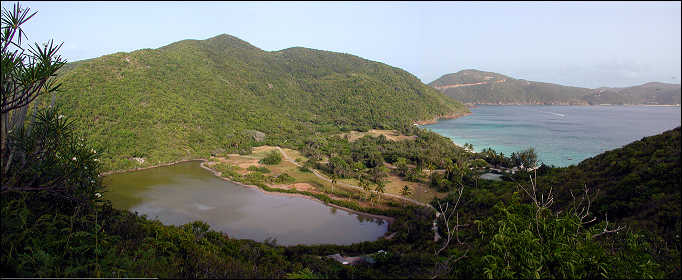From the moment we stepped foot on Guana
Island, we knew we were in for something different. From the dock
at the very edge of a gorgeous white beach, we loaded onto the back of
a customized safari pickup truck/jeep. We sat in the back, arms through
the black rope loops dangling from the shaded canopy, and hung on for dear
life as the assistant manager drove us up the hill and around hairpin turns.
As we rode up the hillside, we looked out at the white sandy beach seeming
to stretch for a mile along the coastline. Further inland, we saw
pink silhouettes of six Caribbean flamingos grazing in a large pond, and
rising from that, two green peaks rising towards the azure blue sky.
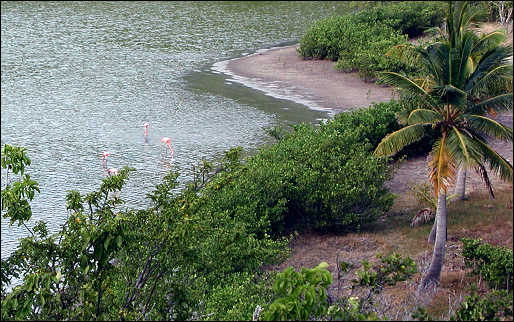
One of the guests later described Guana
as a place that fosters your imagination. Max and I both nodded our
heads – our imaginations were definitely kindled at Guana. At times,
I wouldn't have been surprised to hear an 80 foot dinosaur rumble the volcanic
rock of the island. During hikes, as we scrambled over rocks, boulders,
and through mountain gullies (or ghuts, as they were named on the Guana
Island map), there were brief moments where it seemed we had lost track
of time somewhere, and it seemed as if we had slipped from June 2003 to
June 1903, or 1803, or even 1703.
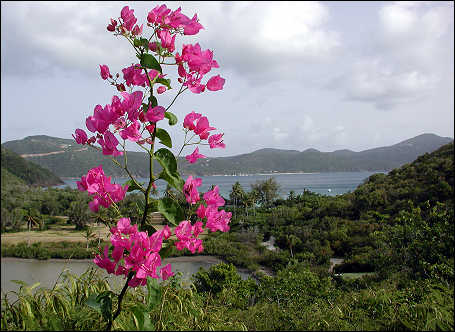
Guana Island has many elements that fuel
the imagination. There are the physical elements: the breathtaking
landscape, 850 acres of wilderness to hike and explore, miles of coral
reefs, and brilliantly hung stars in the sky. There are also pages
and pages of writing about Guana. Every room has a “Natural History
Guide” with information about the flora and fauna of the island, but there
is even more writing laying about the main house – everything from
a report on the archeology and history of the Sugar Mill that operated
throughout the 18th and 19th century, to the history of the island, the
biographies of people associated with Guana, and even very specific biological
reports about the Caribbean flamingo population, the “molecular phylogeny”
of coral reef sea cucumbers, even the ectoparasites that live on small
tropical fish. If you are not into reading on your vacation, the
staff have a wealth of knowledge about the island (Dr. Liao, the island
naturalist, gardener, and trail designer, was here 20 years) and other
guests staying at Guana often share adventures and wildlife sightings over
cocktails at 6:30.
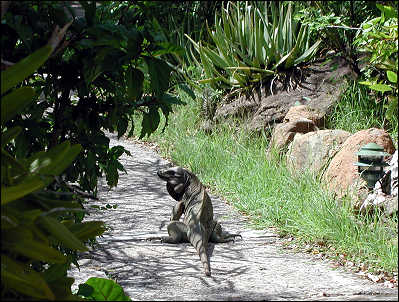
Resort or Retreat?
Guana is most definitely not a typical
resort, which is why in the beginning of our trip, we had a hard time putting
words to our experiences here. We think a better term for this magical
place would be a retreat. And not just any retreat, a retreat in
many senses of the word –
Guana is a physical retreat from the world.
The island sits on the northern edge of the BVI in a space that is somewhere
between the Caribbean Sea and the Atlantic ocean. Sitting on the
verandah of our cottage, I look over to my right at Muskmelon Bay, “the
Atlantic” side of the island, and I gaze over to the left side of our verandah
and see White bay and the Caribbean Sea stretching over to nearby Tortola.
Besides the staff and guests, no one else lives on or even visits this
island. It’s as if you have been invited to a vacation home that
belongs to a friend of your great aunt, and the home just happens to be
on an 850 acre private island.
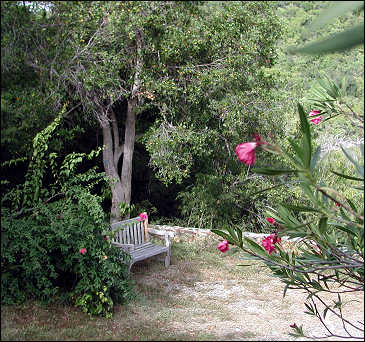
Guana provides a mental retreat from the
busy pace of the world. While there is one phone and computer with
an internet connection available to guests, there are no phones, no TV’s,
not even newspapers on the island. Unlike most resorts where there
are busy schedules to follow (massage on Monday, trip to Virgin Gorda on
Tuesday, snorkel trip on Wednesday, etc.) and structured routines you can
count on, the Guana Island experience is more freeform. While
we stayed here, the only scheduled events were meals and cocktail hours:
breakfast starts at 8:00, lunch begins at 1:00, cocktails at 6:30, and
dinner at 7:30. But even these mealtimes could accommodate our own
pace if we needed them to. We heard the phrase over and over again
from the Guana Island staff, and even the dive-masters at UBS, “whatever
you like, it’s up to you.” What you do on your vacation here is really,
“up to you.” If you can dream it, the Guana Island staff will find
a way to help you make your wish come true.
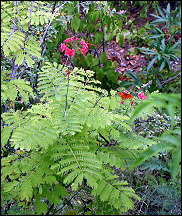 |
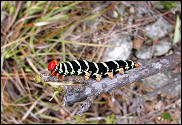 Click for larger picture.
Click for larger picture.
|
|
Guana island is also a fabulous retreat
into the wilderness. There are few islands in the world that harbor
the diversity of the flora and fauna you can find here. For nature
lovers, there are 20 different hiking trails across the island, numerous
beaches and rocky coves to snorkel, and even SCUBA diving if you like.
But to enjoy the wildlife, you don't need to venture far--
Accommodations
Sitting on the verandah of my cottage writing
this article, I am amazed by the wildlife that surround me. As I
write, I hear the low sounding rustling of a three foot iguana adjusting
itself in the bushes to capture the warm morning sun. An emerald
green hummingbird feeds on the flowering 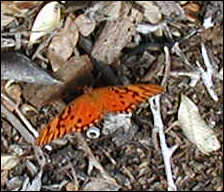 bushes
right off the porch railing and comes to rest on a branch just to the right
of me. I see three types of butterflies, each with their own flight style.
A myriad of small white and yellow butterflies erratically flit from flower
to flower, quickly beating their wings, and look as if any moment they
might suddenly drop to the ground or get blown away by the wind.
The slightly larger, and less numerous black and orange butterflies beat
their wings more slowly. Every once in a while, a larger black butterfly
gracefully glides in, almost never seeming to need to beat its wings to
keep aloft. I take a breath and look over to my left. A kestrel,
its belly speckled and with black vertical stripes masking its head, sits
perched on a tree limb to my left, peering down the hillside. For
what I wonder? Pondering dinner? Taking a rest? I'll
have to continue watching to see. bushes
right off the porch railing and comes to rest on a branch just to the right
of me. I see three types of butterflies, each with their own flight style.
A myriad of small white and yellow butterflies erratically flit from flower
to flower, quickly beating their wings, and look as if any moment they
might suddenly drop to the ground or get blown away by the wind.
The slightly larger, and less numerous black and orange butterflies beat
their wings more slowly. Every once in a while, a larger black butterfly
gracefully glides in, almost never seeming to need to beat its wings to
keep aloft. I take a breath and look over to my left. A kestrel,
its belly speckled and with black vertical stripes masking its head, sits
perched on a tree limb to my left, peering down the hillside. For
what I wonder? Pondering dinner? Taking a rest? I'll
have to continue watching to see.
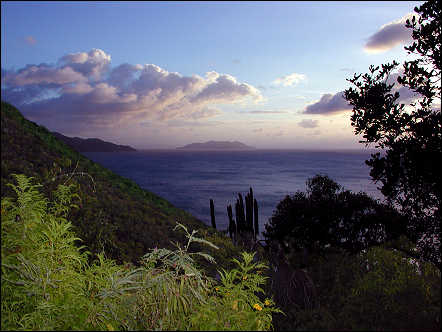
Our cottage had spectacular views of Muskmelon
Bay, opening out into the Atlantic, and White Beach Bay on the Caribbean
side of the island. Our room was fairly spacious, with a large
verandah, a sitting room with a little day bed nook just right for reading,
a bedroom. The bathroom was our favorite room in the cottage.
With a louvered door overlooking white bay, the room caught Caribbean breezes
and the view ... well, it doesn’t get any better than this.
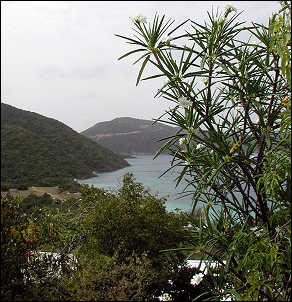
Listening to the Island
We said before that Guana doesn’t have
a resort-type schedule to follow. And officially, there are really
only mealtimes that are scheduled for guests. (The island can help
you arrange day trips, cast away beach getaways, massages, and other adventures
if you like). However, as we spent more time on Guana Island, we
began to realize that we were developing – or learning to develop -- a
vacation schedule based upon the rhythms and patterns of the island itself.
Here are a few ways we learned to follow these rhythms.
The Bat Caves
Corinne: “We thought we would hike
to Long Point this afternoon,” I said casually to Dr. Liao, the island
naturalist, at lunch. “You hike to Long Point in the afternoon?”
He scrunched up his face, put his hand on his green hard-hat, and looked
out towards the valley ravine near the orchard. "Long point is a
very nice hike, but much better in the morning when it is cool. See,”
he said holding his right hand still, as if it were Guana Island, and moving
his left hand as if it were the sun. “In the morning, the sun is
not as hot, and rises over here. Long Point has many dark rocks and
is exposed to the sun. It is not very hot in the morning, when the
sun is over here, he said motioning with his hands, but as the sun moves,
he moved his hand over the top of “the island” and over towards long point,
the rocks get very hot. Better to go there in the morning when it
is still cool.” He thought a minute, and looked back over to his
orchard nestled in the cleavage of the two peaks toward the east.
“In the afternoon, it is better to stay in parts of the island that are
much cooler. Do you see over there, in the valley between the two
mountains? There is much water there, and there are many different
kinds of trees, tall trees, and it stays cool there, even in the afternoon.”
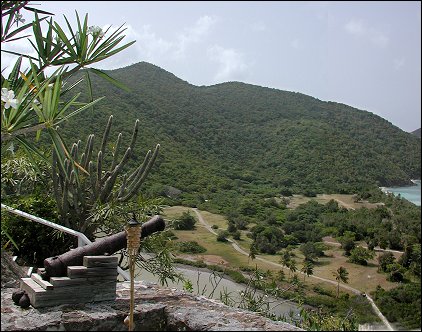
I looked over at the area he was talking
about, and I saw a seam of brighter and taller green zigzagging up the
valley between the two peaks. As I thought about it, it made sense:
the runoff from the two peaks must provide more water to that spot than
other parts of the island that seemed more arid and desert like.
“Up there, there are bat caves, many levels,
like floors of an apartment building. First floor, second floor,
third floor,” he said motioning with his hands, “but not exactly like an
apartment building – the caves get higher and higher but they aren't always
directly above one another. If you like, I can take you there this
afternoon.”
Max: A walk
with Dr. Liao should not be underestimated. We thought Dr. Liao would
be slow given his age, and given the 20 years that he has spent on the
island. We were wrong. My wife and I are 33, and were completely
humbled by this 73 year old man who didn’t really look a day over 50.
Starting from the orchard, we went up the trail to the bald rock halfway
up Sugarloaf hill. Here, Dr. Liao showed us the multiple bat caves
found along the nooks and crannies of the rock. Rated as a medium trail,
we scrambled up the path after Dr. Liao, who is as sure-footed as any mountain
goat. As we struggled behind him, he scampered up the trail pointing
out the various tree species and fauna found on the island.
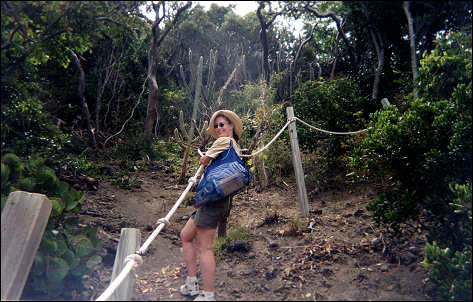
Corinne: Along the way, he helped
us learn to identify trees by their bark and leaf shape. The turpentine
tree, for example, is reddish maroon with very thin white strips of bark
peeling off the trunk. “Some people call this a tourist tree!”
He said with a smile. “Too much sun, and skin peels!” I looked
down at my very white skin – not completely red but peeling -- and laughed.
We passed another tree with a smooth patchy white, cream, and tan bark.
“This is a guavaberry tree. Very hard to grow down in the orchard.
It likes to grow wild up here.”
At a point, two trails, marked by colored
flags tied onto trees, crossed in front of us. “I chose to cross
these two trails here,” he said, “because I love these two trees so much.”
He pointed to one tree, large and stout with gigantic roots reaching up
out of 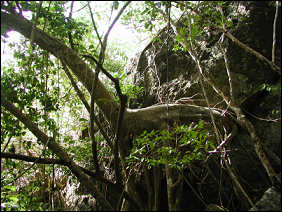 the
soil and back down, and similar tree to the left of the trail. They
looked like two dinosaur legs walking up the mountain. “I love these
two trees, so I made the trail cross here.” He pointed out
another that resembled a giraffe. the
soil and back down, and similar tree to the left of the trail. They
looked like two dinosaur legs walking up the mountain. “I love these
two trees, so I made the trail cross here.” He pointed out
another that resembled a giraffe.
Throughout our hike, we would periodically
stop to take in particular views, or to carefully pick our way up steep
rock like steps. “These not here before,” he said while kicking a
stone, “I put them here to make the trail easier.” Hearing about
the care and thoughtfulness of Dr. Liao's construction of the trails gave
me a particular eye and sensibility as Max and I walked other trails throughout
the week. I found myself noticing particular views, or an unusually
shaped tree, or a cactus growing in a grotto on the side of a cliff.
Max: At various
points along the trail, Dr. Liao would treat us to a poem or song inspired
by the view or a particular tree. When we got to the bat caves, Dr.
Liao pointed out the unique features of each cave to the two of us. For
two of the caves, Dr. Liao did not view our climbing skills to be sufficient
to reach the cave. He was right. We would struggle with the
branches used to reach some of the ledges. I would miss a toehold
along the rocks; Corinne would slip as we rappelled down one section.
Meanwhile Dr. Liao would jump ahead of us, politely pointing out tricky
areas for the two of us. At one point, Dr. Liao scrambled up a 25
foot vertical wall, only using tree limbs as hand holds. All this
to show us a beehive in one of the caves. As we stared in amazement,
he kindly replied that back in China, he had been a mountain climber.
To him, climbing was just a daily exercise.
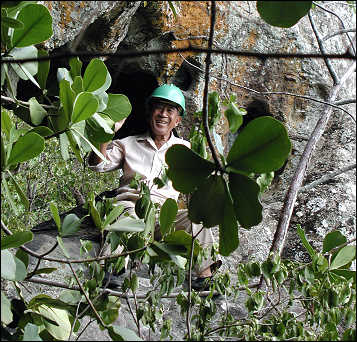 |
Dr. Liao in front
of bat apartment #3.
There are at least
three kinds of bats on the island – insect eating bats, fruit eating bats,
and fish eating bats. |
Corinne: Max and I watched with
amazement as Dr. Liao scaled a 25 foot wall -- seemingly effortless as
he found toeholds simultaneously in the rock and in nearby flexible tree
and vine branches. “Be careful where you put your foot,” he said
to us over and over on the hike, “choose your steps carefully. Watch
for loose rocks, jumping cactus. Go slowly, slowly. Take time
to look at the tree, the flowers, the sky.” It was as if he was letting
us in on his secret to convening with the flora, the fauna, even the rocks
of the island. Pay attention to the small things. Take your
time. Go slowly. Find a way to remember these moments – write
a song, take a picture, or meditate for a moment.
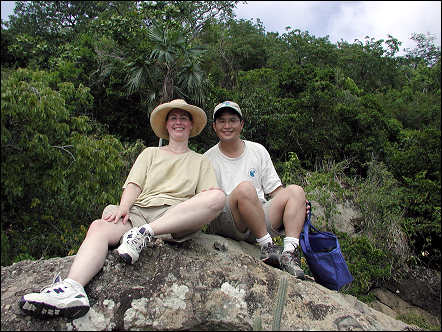
Hike to Long Point.
Corinne: I have to say, our hike
to Long Point was one of the highlights of our trip. After breakfast,
around 9:00, we checked in with the managers to arrange for a boat to come
around to the point to pick us up around noon. We set off, following
little blue flags tied to trees. At the first fork, we took Dr. Liao's
advice and took the shadier left trail.
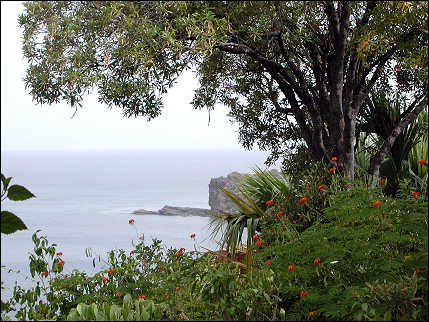
As we hiked around towards the point,
I could feel subtle climate changes in the temperature and vegetation.
The more barren places had arid dry soil, with numerous varieties of cactus
and scrubby little trees covered with bromeliads. The lusher forest
had a taller and cooler canopy that housed more birds (we could tell by
the chatter and bickering of the bananaquites and the calls of the thrushes,
“mine, yours, mine, yours.”)
I could tell that we were beginning to
listen to the island – feeling, hearing, sensing these subtle changes in
micro-climates. Max and I were becoming more adept at noticing spider
webs stretched across the path (and following Dr. Liao's lead by apologizing
to the spider before moving the web aside with a stick).
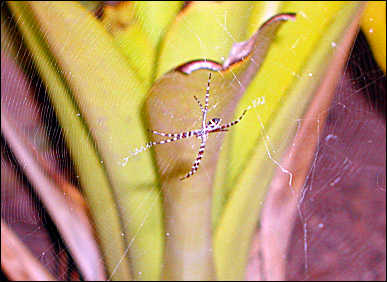
We found ourselves stopping periodically
to admire little things – a small cactus growing deep in a rock grotto,
an upturned root in the shape of a rabbit, the oddly linear shape, almost
roof-like, of the top of a tree.
At the second fork, we chose to go right
to hike down to table rock. As we broke through the forest, we had
a view of the Atlantic – it seemed to stretch for miles and miles.
We scrambled over great black heaves of volcanic boulders and rocks that
seemed casually tumbled and tossed at the edge of the island. I felt
the cool breeze and sensed the warming rock under my feet and was thankful
we decided not to come out here in the afternoon. It would have been
like sizzling on an iron skillet.
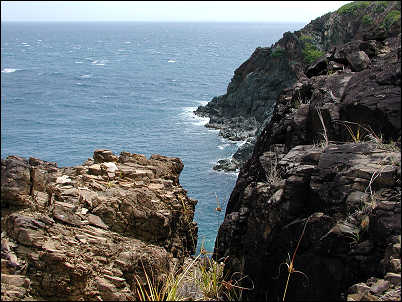
Table rock, looking like an antique copper
platter, oxidized green with age, stretched smooth among the rougher tumbles
of pumice. At the end of table rock, we saw a great split in the
rocks plunging into the sea. I imagined what the reef – encrusted
with sponges, fish darting in and out of the crevices, a shark sleeping
under a ledge – looked like below.
We continued on towards Chicken Rock.
As we walked along the rocky edge of the island, it seemed to me that we
were walking along the edge of the world – the sea endlessly stretching
to a flat horizon. I toyed with images of falling off flat
worlds, large sea monsters living at the edge, mouths open wide waiting
for those who tread too far…but my imagination is running away with me
again (a common occurrence for me at Guana).
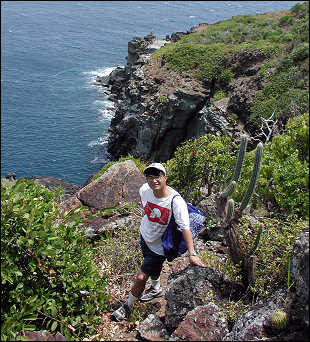
We reached a very steep and narrow bit
of rock right on the edge of a cliff. “Take off your backpack, Corinne,”
Max said to me, his hand outstretched, “there’s no way you will make it
under this under hang with the pack on your back. Oh, and don't look
down.” Silly me, I looked down in time to see several loose pebbles
tumble down the side of the cliff and into the Atlantic Ocean. I
closed my eyes, ducked under the rock and scurried up the side of the next
rock. Truly, we were on the edge of the world.
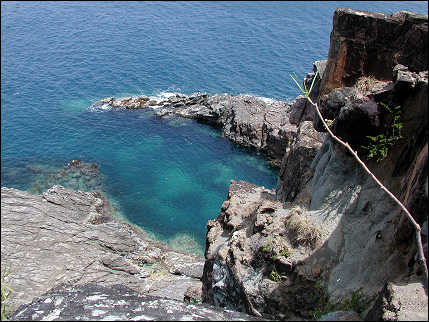
We continued on, and finally made it to
“the steps” – a set of concrete steps leading down and splitting into two
– one stairway leading down into Muskmelon Bay, and the other leading to
a group of black boulders leading towards the point.
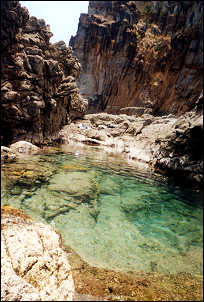 We
chose the right path, carefully picking our way across the rocks and around
the point to a series of small pools – three large ones, but several smaller
ones. Imagine a salt water oasis, or giant tidal pools reflecting
cool shades of aquamarine, teal, azure blue. We walked from pool
to pool, deciding which one to swim in. The furthest looked a bit
dangerous – the swells heaved in over the rocks and we imagined a strong
current in the water. We chose two smaller pools closer to the point
that were fed by the ocean surges. Avoiding the bright orange
fire coral, we slipped into the cool waters of the pool. Schools
of blue tang, and many different kinds of smaller fish fry darted in and
out of the rocks. Rolling on my back, I watched the pelicans hover
and dive into the deeper waters of the Atlantic, just seven feet or so
away beyond our protected little paradise. We
chose the right path, carefully picking our way across the rocks and around
the point to a series of small pools – three large ones, but several smaller
ones. Imagine a salt water oasis, or giant tidal pools reflecting
cool shades of aquamarine, teal, azure blue. We walked from pool
to pool, deciding which one to swim in. The furthest looked a bit
dangerous – the swells heaved in over the rocks and we imagined a strong
current in the water. We chose two smaller pools closer to the point
that were fed by the ocean surges. Avoiding the bright orange
fire coral, we slipped into the cool waters of the pool. Schools
of blue tang, and many different kinds of smaller fish fry darted in and
out of the rocks. Rolling on my back, I watched the pelicans hover
and dive into the deeper waters of the Atlantic, just seven feet or so
away beyond our protected little paradise.
Lunch
Lunch: Max and I arrive, freshly
showered from our morning hike to long point, but are exhausted and dehydrated.
I pour myself a cool lemonade and eye the dishes spread along the buffet
table. As I ponder what to eat, the a door swings open in the breeze,
the faint harmonies and long notes of gospel music drift from the kitchen.
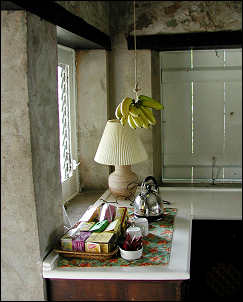 For
me, the food here at Guana stirred up memories of my grandmother Hattie
Bell's home cooking. Everything – the fish, the spices, the fruit
– is fresh (much of the fruit is harvested from the organic orchard at
the base of the Sugarloaf mountain such as the banana shown in the picture),
and this makes a big difference in the quality of the food. It’s
hard to make a terrible meal when your fish swam in the ocean in the morning.
For those of you that haven't had the pleasure of eating at my grandmother's
table, the food here is reminiscent of “the Junior League cookbook meets
the Caribbean,” with lots of salads ranging from iceberg with tomato to
“plantain salad,” “sweet potato salad with tumeric,” “fried squid salad,”
and even “seaweed salad.” Lunches often brought Caribbean inspired
fare – fall off the bone tender barbecued chicken, spiced flank steak,
eggplant-mushroom tureen with just a hint of truffle to deepen the flavor.
Dinner is a little more dressed up: shrimp Creole, broiled redfish,
pork tenderloins. The best way to describe the food here is that
it is simple, fresh, and magnificent, particularly with the complementary
red and white wine that accompanies dinner each night. For
me, the food here at Guana stirred up memories of my grandmother Hattie
Bell's home cooking. Everything – the fish, the spices, the fruit
– is fresh (much of the fruit is harvested from the organic orchard at
the base of the Sugarloaf mountain such as the banana shown in the picture),
and this makes a big difference in the quality of the food. It’s
hard to make a terrible meal when your fish swam in the ocean in the morning.
For those of you that haven't had the pleasure of eating at my grandmother's
table, the food here is reminiscent of “the Junior League cookbook meets
the Caribbean,” with lots of salads ranging from iceberg with tomato to
“plantain salad,” “sweet potato salad with tumeric,” “fried squid salad,”
and even “seaweed salad.” Lunches often brought Caribbean inspired
fare – fall off the bone tender barbecued chicken, spiced flank steak,
eggplant-mushroom tureen with just a hint of truffle to deepen the flavor.
Dinner is a little more dressed up: shrimp Creole, broiled redfish,
pork tenderloins. The best way to describe the food here is that
it is simple, fresh, and magnificent, particularly with the complementary
red and white wine that accompanies dinner each night.
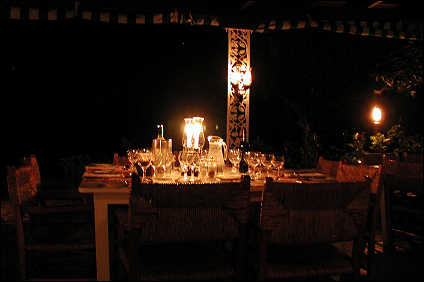
Max: Don't
expect fancy “celebrity chef” cuisine at Guana Island. The food here
is uncomplicated and fresh. My favorite lunch was the chicken roti
– a tender curried chicken wrapped in a Caribbean flaky pastry.
Listening to Guana
The longer we stayed at Guana Island,
the more we were around different people who lived or worked here -- Dr.
Liao, our dive-masters, the managers -- the more we learned to take cues
from the island about our daily schedules and plans. Hike the arid
parts of the island in the morning, and for long trips, ask for a boat
ride back to the dock. If you want to hike in the afternoon, choose
to hike the cooler and shady ravines or “ghuts” as they are called on the
map. Dive the north and eastern sides of the island in the summer
months (June-early October) when the Atlantic is tamer than the white capped
winter months. Take naps in the afternoon in the heat of the day.
White beach often has nice afternoon breezes in the late afternoon.
The sitting room where people often gather for 7:00 cocktails, with both
doors open, one to the Atlantic and the other to the Caribbean Sea, captured
cross winds and breezes much better than our cottage (there is a reason
people gather in that room for cocktails at 7!).
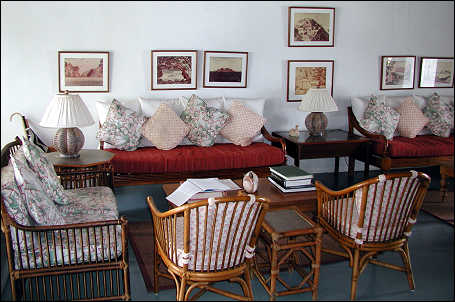
While these weren't hard and fast “rules,”
they are patterns which we intuitively fell into as we experienced and
learned more about the island. The other guests, we noticed, found
their own patterns and schedules that seemed to fit them and the island.
Talking with my parents, who have continued to return to Guana over the
years, their schedule and experiences seem different from ours. Guana
Island is a place that provides a space for guests to capture and experience
the power of their imaginations, if only for brief moments. Each
guest has their own imagination, and so each person's experience of the
island is personalized and unique – a true Caribbean Retreat.
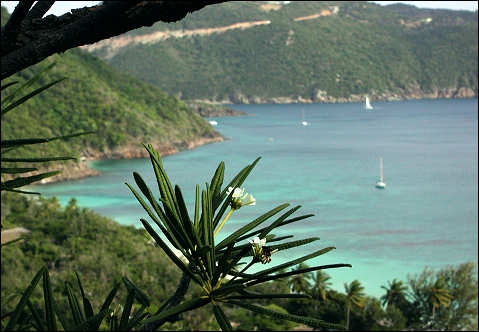
|
